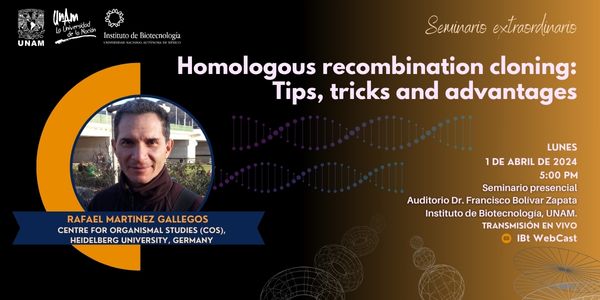
01Abr - 2024
Homologous recombination cloning: Tips, tricks and advantages
05:00 PM - 07:00 PM|Dr. Rafael Martinez Gallegos|Developmental Biology, Centre for Organismal Studies (COS), Heidelberg University, Germany|Invitado por: Joseph Dubrovsky
Seminario
Using the endogenous homologous recombination of living organisms for cloning (HR-cloning) was first described in yeast and eventually in bacteria. Although not so widespread, this method allows the straightforward engineering of fusion proteins with the ability of exchanging elements from 1 nt to several kb within a plasmid. Therefore it can be used to manipulate codons or transcription factor target sequences as well as to study regulatory regions like full promoters or UTRs. Likewise, reporter markers can be exchanged having either N- or C-terminal variants. It also offers the possibility of engineering customized plasmids providing a different strategy to overcome difficulties in the cloning and editing of challenging DNA fragments. The manipulation steps are minimized and any recA1 bacteria strain is suitable for it. This method has been tested with common and customized plasmids with a range up to 15 kb. Its simplicity allows the implementation in any molecular biology laboratory without the requirement of any commercial Kit. I will discuss examples of HR-cloning on a wide variety of organisms, from plants to Drosophila.
Actualizado 2024-03-11 17:26:35
29-Abril-2024 al 29-Abril-2024
12:00 PM
Dr. Javier Ignacio Sánchez Villamil
12:00 PM
Dr. Javier Ignacio Sánchez Villamil
Nanotecnología aplicada al desarrollo de vacunas contra patógenos complejos
El campo del desarrollo de vacunas ha visto un aumento en la cantidad de tecnologías diseñadas estratégicamente para incrementar la eficacia contra patógenos resistentes a las vacunas, sin comprometer la seguridad. En particular, nuestros estudios con nanopartículas de oro (AuNP) acopladas a antígenos previamente seleccionados por vacunología inversa mostraron una potente respuesta humoral y celular específica contra bacterias complejas como Burkholderia pseudomallei, B. mallei y Escherichia coli enterohemorrágica (EHEC), protegiendo contra la infección letal y la colonización intestinal respectivamente en modelos animales. El potencial de B. pseudomallei, B. mallei y EHEC para causar una enfermedad mortal en humanos, dosis infecciosas bajas, resistencia a múltiples antibióticos, la falta de tratamiento efectivo y la endemicidad América Latina destaca el desarrollo de vacunas eficaces en el campo de las enfermedades infecciosas emergentes. Estos estudios proporcionan la base para una elegante y refinada formulación de vacunas glicoconjugadas multicomponente capaces de inducir respuestas humorales y mediadas por células contra patógenos bacterianos complejos.



